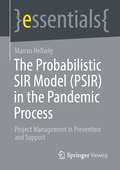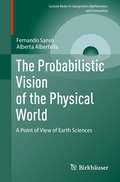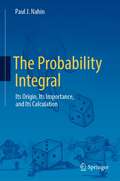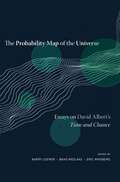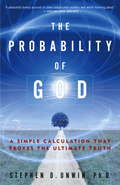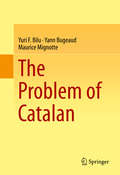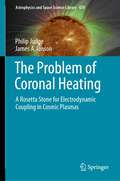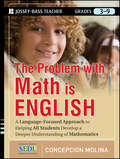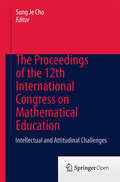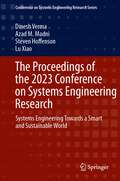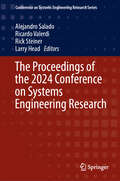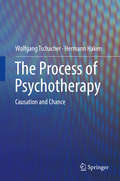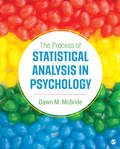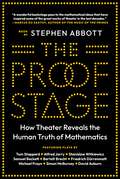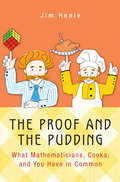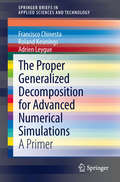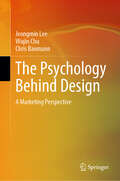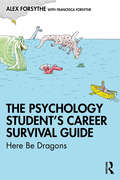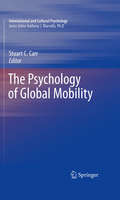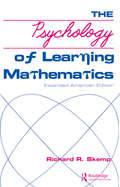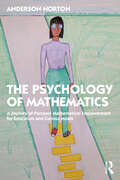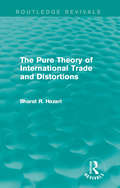- Table View
- List View
The Probabilistic SIR Model: Project Management in Prevention and Support (essentials)
by Marcus HellwigWith all the insights experienced in the COVID process, one essential remains: "The virus remains a constant companion". In contrast to regularly occurring infection processes, a COVID infection takes a different course. This is characterized by a dynamic that deviates from conventional, well-known processes in that the originators change their identity and develop corresponding variants. Therefore, preventive infection management - supported by statistical-probabilistic analyzes with PSIR - is important for preventive management of resources and infrastructure for the "waves ahead of the wave".
The Probabilistic Vision of the Physical World: A Point of View of Earth Sciences (Lecture Notes in Geosystems Mathematics and Computing)
by Fernando Sansò Alberta AlbertellaThis book investigates the relationship between empirical reality and theoretical modelling in Earth sciences, focusing on how empirical experiments and theoretical models interact. It explores the connection between statistics and probability theory, emphasizing the importance of these tools in understanding the physical world. The first chapter addresses the frequency-probability antinomy, while the second chapter discusses the sources of randomness in modelling. Chapters 3 and 4 delve into statistical inference, covering estimation theory and testing theory. Chapter 5 examines the relationship between discrete-finite models and continuous-infinite dimensional models, particularly random fields, making the concepts accessible to geodesists and geophysicists. Chapter 6 explores modern machine learning and deep learning, highlighting their roots in traditional statistical methods and neural networks. The book concludes with a caution against relying solely on empirical evidence and "black box" algorithms, advocating for the integration of physical laws with empirical models to advance understanding of the physical world. The book is primarily intended for graduate students and researchers in the field of earth sciences with a basic background in probability theory and statistics.
The Probability Companion for Engineering and Computer Science
by Adam Prügel-BennettThis friendly guide is the companion you need to convert pure mathematics into understanding and facility with a host of probabilistic tools. The book provides a high-level view of probability and its most powerful applications. It begins with the basic rules of probability and quickly progresses to some of the most sophisticated modern techniques in use, including Kalman filters, Monte Carlo techniques, machine learning methods, Bayesian inference and stochastic processes. It draws on thirty years of experience in applying probabilistic methods to problems in computational science and engineering, and numerous practical examples illustrate where these techniques are used in the real world. Topics of discussion range from carbon dating to Wasserstein GANs, one of the most recent developments in Deep Learning. The underlying mathematics is presented in full, but clarity takes priority over complete rigour, making this text a starting reference source for researchers and a readable overview for students.
The Probability Integral: Its Origin, Its Importance, and Its Calculation
by Paul J. NahinThis book tells the story of the probability integral, the approaches to analyzing it throughout history, and the many areas of science where it arises. The so-called probability integral, the integral over the real line of a Gaussian function, occurs ubiquitously in mathematics, physics, engineering and probability theory. Stubbornly resistant to the undergraduate toolkit for handling integrals, calculating its value and investigating its properties occupied such mathematical luminaries as De Moivre, Laplace, Poisson, and Liouville. This book introduces the probability integral, puts it into a historical context, and describes the different approaches throughout history to evaluate and analyze it. The author also takes entertaining diversions into areas of math, science, and engineering where the probability integral arises: as well as being indispensable to probability theory and statistics, it also shows up naturally in thermodynamics and signal processing. Designed to be accessible to anyone at the undergraduate level and above, this book will appeal to anyone interested in integration techniques, as well as historians of math, science, and statistics.
The Probability Map of the Universe: Essays on David Albert’s <i>Time and Chance</i>
by Barry Loewer, Brad Weslake, and Eric WinsbergPhilosophers debate the ideas and implications of one of the most important contemporary works in the philosophy of science, David Albert’s Time and Chance.In the twenty-odd years since its publication, David Albert’s Time and Chance has been recognized as one of the most significant contemporary contributions to the philosophy of science. Here, philosophers and physicists explore the implications of Albert’s arguments and debate his solutions to some of the most intractable problems in theoretical physics.Albert has attempted to make sense of the tension between our best scientific pictures of the fundamental physical structure of the world and our everyday empirical experience of that world. In particular, he is concerned with problems arising from causality and the direction of time: defying common sense, almost all our basic scientific ideas suggest that whatever can happen can just as naturally happen in reverse. Focusing on Newtonian mechanics, Albert provides a systematic account of the temporal irreversibility of the Second Law of Thermodynamics, of the asymmetries in our epistemic access to the past and the future, and of our conviction that by acting now we can affect the future but not the past. He also generalizes the Newtonian picture to the quantum-mechanical case and suggests a deep potential connection between the problem of the direction of time and the quantum-mechanical measurement problem.The essays included in The Probability Map of the Universe develop, explore, and critique this account, while Albert himself replies. The result is an insightful discussion of the foundations of statistical mechanics and its relation to cosmology, the direction of time, and the metaphysical nature of laws and objective probability.
The Probability of God: A Simple Calculation That Proves the Ultimate Truth
by Dr. Stephen D. UnwinDoes God exist?This is probably the most debated question in the history of mankind. Scholars, scientists, and philosophers have spent their lifetimes trying to prove or disprove the existence of God, only to have their theories crucified by other scholars, scientists, and philosophers. Where the debate breaks down is in the ambiguities and colloquialisms of language. But, by using a universal, unambiguous language—namely, mathematics—can this question finally be answered definitively? That’s what Dr. Stephen Unwin attempts to do in this riveting, accessible, and witty book, The Probability of God.At its core, this groundbreaking book reveals how a math equation developed more than 200 years ago by noted European philosopher Thomas Bayes can be used to calculate the probability that God exists. The equation itself is much more complicated than a simple coin toss (heads, He’s up there running the show; tails, He’s not). Yet Dr. Unwin writes with a clarity that makes his mathematical proof easy for even the nonmathematician to understand and a verve that makes his book a delight to read. Leading you carefully through each step in his argument, he demonstrates in the end that God does indeed exist.Whether you’re a devout believer and agree with Dr. Unwin’s proof or are unsure about all things divine, you will find this provocative book enlightening and engaging.
The Problem of Catalan
by Yann Bugeaud Yuri F. Bilu Maurice MignotteIn 1842 the Belgian mathematician Eugène Charles Catalan asked whether 8 and 9 are the only consecutive pure powers of non-zero integers. 160 years after, the question was answered affirmatively by the Swiss mathematician of Romanian origin Preda MihÄfilescu. In other words, 32 - 23 = 1 is the only solution of the equation xp - yq = 1 in integers x, y, p, q with xy ≠ 0 and p, q ≥ 2. In this book we give a complete and (almost) self-contained exposition of MihÄfilescu's work, which must be understandable by a curious university student, not necessarily specializing in Number Theory. We assume a very modest background:a standard university course of algebra, including basic Galois theory, and working knowledge of basic algebraic number theory.
The Problem of Coronal Heating: A Rosetta Stone for Electrodynamic Coupling in Cosmic Plasmas (Astrophysics and Space Science Library #470)
by Philip Judge James A. IonsonThis book reflects on 8 decades of research on one of the longest-standing unsolved problems in modern astrophysics: why does the Sun form a hot corona? The authors give a critical overview of the field and offer suggestions on how to bridge the chasm between what we can measure, and what we can calculate. They go back to basics to explain why the problem is difficult, where we have made progress and where we have not, to help the next generation of scientists devise novel techniques to crack such a long-lasting problem. A way forward is formulated centered around refutation, using Bayesian methods to propose and to try to reject hypotheses and models, and avoiding seduction by ``confirmation bias’’.This book is aimed at physicists, students and researchers interested in understanding, learning from and solving the coronal heating problem, in an era of new dedicated facilities such as the Parker Solar Probe and the Daniel K. Inouye Solar Telescope. Thebook will appeal to those interested in understanding research methods and how they are changing in the modern academic environment, particular in astrophysics and Earth sciences where remote sensing is essential.
The Problem with Math Is English: A Language-Focused Approach to Helping All Students Develop a Deeper Understanding of Mathematics
by Concepcion MolinaTeaching K-12 math becomes an easier task when everyone understands the language, symbolism, and representation of math concepts Published in partnership with SEDL, The Problem with Math Is English illustrates how students often understand fundamental mathematical concepts at a superficial level. <P><P>Written to inspire ?aha? moments, this book enables teachers to help students identify and comprehend the nuances and true meaning of math concepts by exploring them through the lenses of language and symbolism, delving into such essential topics as multiplication, division, fractions, place value, proportional reasoning, graphs, slope, order of operations, and the distributive property. Offers a new way to approach teaching math content in a way that will improve how all students, and especially English language learners, understand math Emphasizes major attributes of conceptual understanding in mathematics, including simple yet deep definitions of key terms, connections among key topics, and insightful interpretation This important new book fills a gap in math education by illustrating how a deeper knowledge of math concepts can be developed in all students through a focus on language and symbolism.
The Proceedings of the 12th International Congress on Mathematical Education
by Sung Je ChoThis book comprises the Proceedings of the 12th International Congress on Mathematical Education (ICME-12), which was held at COEX in Seoul, Korea, from July 8th to 15th, 2012. ICME-12 brought together 3500 experts from 92 countries, working to understand all of the intellectual and attitudinal challenges in the subject of mathematics education as a multidisciplinary research and practice. This work aims to serve as a platform for deeper, more sensitive and more collaborative involvement of all major contributors towards educational improvement and in research on the nature of teaching and learning in mathematics education. It introduces the major activities of ICME-12 which have successfully contributed to the sustainable development of mathematics education across the world. The program provides food for thought and inspiration for practice for everyone with an interest in mathematics education and makes an essential reference for teacher educators, curriculum developers and researchers in mathematics education. The work includes the texts of the four plenary lectures and three plenary panels and reports of three survey groups, five National presentations, the abstracts of fifty one Regular lectures, reports of thirty seven Topic Study Groups and seventeen Discussion Groups.
The Proceedings of the 2023 Conference on Systems Engineering Research: Systems Engineering Towards a Smart and Sustainable World (Conference on Systems Engineering Research Series)
by Azad M. Madni Dinesh Verma Lu Xiao Steven HoffensonThe 20th International Conference on Systems Engineering Research (CSER 2023) pushes the boundaries of systems engineering research and responds to new challenges for systems engineering. CSER 2023 invited researchers and practitioners to submit their work in alignment with the thematic focus on a smart and sustainable world. CSER was founded in 2003 by Stevens Institute of Technology and the University of Southern California, and in 2023 the conference returned to the Stevens campus in Hoboken, New Jersey.
The Proceedings of the 2024 Conference on Systems Engineering Research (Conference on Systems Engineering Research Series)
by Rick Steiner Ricardo Valerdi Alejandro Salado Larry HeadThe 22nd International Conference on Systems Engineering Research (CSER 2024) pushes the boundaries of systems engineering research and responds to new challenges for systems engineering. CSER was founded in 2003 by Stevens Institute of Technology and the University of Southern California. In 2024 the conference was hosted by the University of Arizona, home to the first-ever established Department of Systems Engineering. The following foundational research topics are included: • Scientific Foundations of Systems Engineering • Digital Engineering, Digital Twins • Digital Transformation • Advances in Model-Based Systems Engineering (MBSE) • Value-based and Agile Systems Engineering • Artificial Intelligence for Systems and Software Engineering (AI4SE) • Systems and Software Engineering for Artificial Intelligence (SE4AI) • Cybersecurity and System Security Engineering • Uncertainty and Complexity Management • Trust and Autonomous Systems • Human-Systems Integration • Systems of Systems • Social Systems Engineering • Systems Thinking • Advances in requirements engineering, systems architecture, systems integration, and verification and validation. The 21st Annual Conference on Systems Engineering Research (CSER 2024) was poised to push the boundaries of systems engineering, embracing a wide array of themes from its scientific underpinnings to the forefront of digital engineering transformation and the seamless integration of artificial intelligence within systems and software engineering. Delving into cutting-edge topics such as Model-Based Systems Engineering (MBSE), cybersecurity, and the management of uncertainty and complexity, CSER 2024 tackled the varied challenges and seize the opportunities emerging in the field. The conference's commitment to blending theoretical insights with practical innovations makes it a pivotal event for the systems engineering community.
The Process of Psychotherapy: Causation and Chance
by Hermann Haken Wolfgang TschacherThis book describes an encompassing modeling approach to psychotherapy, created with the most recent research in the field. Therapeutic interventions are staged within a therapist-client relationship ('alliance'), and become effective by the interplay of deterministic ('causation') and stochastic ('chance') forces. The authors use a Fokker-Planck approach complemented by a structural-mathematical framework from complexity theory. Chapters present statistical tools, which can be applied to analyze the differing time series that depict therapeutic processes. Chapters include examples of how to use these tools within research. The approach adopted in the book – contemporary psychotherapy terminology combined with a systems-theoretical model and algorithms for quantitative psychotherapy research – has the potential to become the new benchmark in psychotherapy. The Process of Psychotherapy is an informative and sophisticated resource for all levels of students, from undergraduate through post-doctoral studies, in the fields of psychology, cognitive psychology, and psychotherapy.
The Process of Statistical Analysis in Psychology: Mcbride: The Process Of Statistical Analysis In Psychology (paperback) + Mcbride: The Process Of Statistical Analysis In Psychology (paperback)
by Dawn M. McBrideThis new introductory statistics text from Dawn M. McBride, best-selling author of The Process of Research in Psychology, covers the background and process of statistical analysis, along with how to use essential tools for working with data from the field. Research studies are included throughout from both the perspective of a student conducting their own research study and of someone encountering research in their daily life. McBride helps readers gain the knowledge they need to become better consumers of research and statistics used in everyday decision-making and connects the process of research design with the tools employed in statistical analysis. Instructors and students alike will appreciate the extra opportunities for practice with the accompanying Lab Manual for Statistical Analysis, also written by McBride and her frequent collaborator, J. Cooper Cutting.
The Process of Statistical Analysis in Psychology: The Process of Statistical Analysis in Psychology
by Dawn M. McBrideThis new introductory statistics text from Dawn M. McBride, best-selling author of The Process of Research in Psychology, covers the background and process of statistical analysis, along with how to use essential tools for working with data from the field. Research studies are included throughout from both the perspective of a student conducting their own research study and of someone encountering research in their daily life. McBride helps readers gain the knowledge they need to become better consumers of research and statistics used in everyday decision-making and connects the process of research design with the tools employed in statistical analysis. Instructors and students alike will appreciate the extra opportunities for practice with the accompanying Lab Manual for Statistical Analysis, also written by McBride and her frequent collaborator, J. Cooper Cutting.
The Projected Subgradient Algorithm in Convex Optimization (SpringerBriefs in Optimization)
by Alexander J. ZaslavskiThis focused monograph presents a study of subgradient algorithms for constrained minimization problems in a Hilbert space. The book is of interest for experts in applications of optimization to engineering and economics. The goal is to obtain a good approximate solution of the problem in the presence of computational errors. The discussion takes into consideration the fact that for every algorithm its iteration consists of several steps and that computational errors for different steps are different, in general. The book is especially useful for the reader because it contains solutions to a number of difficult and interesting problems in the numerical optimization. The subgradient projection algorithm is one of the most important tools in optimization theory and its applications. An optimization problem is described by an objective function and a set of feasible points. For this algorithm each iteration consists of two steps. The first step requires a calculation of a subgradient of the objective function; the second requires a calculation of a projection on the feasible set. The computational errors in each of these two steps are different. This book shows that the algorithm discussed, generates a good approximate solution, if all the computational errors are bounded from above by a small positive constant. Moreover, if computational errors for the two steps of the algorithm are known, one discovers an approximate solution and how many iterations one needs for this. In addition to their mathematical interest, the generalizations considered in this book have a significant practical meaning.
The Proof Stage: How Theater Reveals the Human Truth of Mathematics
by Stephen AbbottHow playwrights from Alfred Jarry and Samuel Beckett to Tom Stoppard and Simon McBurney brought the power of mathematics to life on the stageThe discovery of alternate geometries, paradoxes of the infinite, incompleteness, and chaos theory revealed that, despite its reputation for certainty, mathematical truth is not immutable, perfect, or even perfectible. Beginning in the last century, a handful of adventurous playwrights took inspiration from the fractures of modern mathematics to expand their own artistic boundaries. Originating in the early avant-garde, mathematics-infused theater reached a popular apex in Tom Stoppard&’s 1993 play Arcadia. In The Proof Stage, mathematician Stephen Abbott explores this unlikely collaboration of theater and mathematics. He probes the impact of mathematics on such influential writers as Alfred Jarry, Samuel Beckett, Bertolt Brecht, and Stoppard, and delves into the life and mathematics of Alan Turing as they are rendered onstage. The result is an unexpected story about the mutually illuminating relationship between proofs and plays—from Euclid and Euripides to Gödel and Godot.Theater is uniquely poised to discover the soulful, human truths embedded in the austere theorems of mathematics, but this is a difficult feat. It took Stoppard twenty-five years of experimenting with the creative possibilities of mathematics before he succeeded in making fractal geometry and chaos theory integral to Arcadia&’s emotional arc. In addition to charting Stoppard&’s journey, Abbott examines the post-Arcadia wave of ambitious works by Michael Frayn, David Auburn, Simon McBurney, Snoo Wilson, John Mighton, and others. Collectively, these gifted playwrights transform the great philosophical upheavals of mathematics into profound and sometimes poignant revelations about the human journey.
The Proof and the Pudding
by Jim HenleTie on your apron and step into Jim Henle's kitchen as he demonstrates how two equally savory pursuits--cooking and mathematics--have more in common than you realize. A tasty dish for gourmets of popular math, The Proof and the Pudding offers a witty and flavorful blend of mathematical treats and gastronomic delights that reveal how life in the mathematical world is tantalizingly similar to life in the kitchen.Take a tricky Sudoku puzzle and a cake that fell. Henle shows you that the best way to deal with cooking disasters is also the best way to solve math problems. Or take an L-shaped billiard table and a sudden desire for Italian potstickers. He explains how preferring geometry over algebra (or algebra over geometry) is just like preferring a California roll to chicken tikka masala. Do you want to know why playfulness is rampant in math and cooking? Or how to turn stinky cheese into an awesome ice cream treat? It's all here: original math and original recipes plus the mathematical equivalents of vegetarianism, Asian fusion, and celebrity chefs.Pleasurable and lighthearted, The Proof and the Pudding is a feast for the intellect as well as the palate.
The Proper Generalized Decomposition for Advanced Numerical Simulations
by Francisco Chinesta Roland Keunings Adrien LeygueMany problems in scientific computing are intractable with classical numerical techniques. These fail, for example, in the solution of high-dimensional models due to the exponential increase of the number of degrees of freedom. Recently, the authors of this book and their collaborators have developed a novel technique, called Proper Generalized Decomposition (PGD) that has proven to be a significant step forward. The PGD builds by means of a successive enrichment strategy a numerical approximation of the unknown fields in a separated form. Although first introduced and successfully demonstrated in the context of high-dimensional problems, the PGD allows for a completely new approach for addressing more standard problems in science and engineering. Indeed, many challenging problems can be efficiently cast into a multi-dimensional framework, thus opening entirely new solution strategies in the PGD framework. For instance, the material parameters and boundary conditions appearing in a particular mathematical model can be regarded as extra-coordinates of the problem in addition to the usual coordinates such as space and time. In the PGD framework, this enriched model is solved only once to yield a parametric solution that includes all particular solutions for specific values of the parameters. The PGD has now attracted the attention of a large number of research groups worldwide. The present text is the first available book describing the PGD. It provides a very readable and practical introduction that allows the reader to quickly grasp the main features of the method Throughout the book, the PGD is applied to problems of increasing complexity, and the methodology is illustrated by means of carefully selected numerical examples. Moreover, the reader has free access to the Matlab© software used to generate these examples.
The Psychology Behind Design: A Marketing Perspective
by Chris Baumann Jeongmin Lee Wujin ChuThis book explains the psychology theory behind design using plain language. The inspiration came from the "democratic design" philosophy of IKEA. This book attempts to help people enjoy designs more, by explaining consumer psychology that lurks behind designs of everyday things. Another purpose of the book is to aid designers and marketers in understanding consumer behavior and to help them leverage this knowledge in their respective fields. Marketers and designers often find it hard to communicate effectively due to their disparate fields. However, this book aims to bridge this gap by showing that activities in both design and marketing can be better understood through the lens of design psychology, promoting better communication and collaboration. Although the book contains more than a hundred psychology theories that can affect design, it is structured in a reader-friendly manner, and chapters are segmented such that each chapter contains about 7~15 theories. Despite the large amount of academic research behind the theories, the application of these theories comes from commonplace consumer behaviors and daily design examples, promising an easy, relatable read.
The Psychology Student’s Career Survival Guide: Here Be Dragons
by Alex ForsytheThe Psychology Student’s Career Survival Guide is designed to aid students in identifying their ideal career pathway and imbue them with the right tools and skills to not only achieve their desired job but to progress and thrive within the workplace. The first half of the book focuses on how to find and get a suitable job. The remaining chapters explore gaining success in the workplace in terms of personal growth, navigating criticism, workplace relations and the critical job assignments that every graduate should pursue. Forsythe, an experienced organisational psychologist, helps students recognise and apply the acquired psychological skill set to develop a personal brand, increase personal visibility and develop professional networks. This smooths the transition from university into the world of work by developing effective working practices that will support personal performance and that of the workplace. This book can also serve as a practical guide for academics looking to bridge the gap between the developing student at university and demands of their future employers. It explicitly calls for vocational elements such as communication, team-working, goal setting and planning within the curriculum. This engaging book comes with an abundance of resources to support students' individual development and to help academics run workshops. These resources include tool kits which include self-diagnostic tools and strengths finders, networking skill development, job search strategies, difficult interview questions, personal branding and so on. This is an essential text for psychology students at all levels looking for employability guidance and for psychology academics who are seeking supportive resources and guidance on helping students achieve their career ambitions.
The Psychology of Global Mobility
by Stuart C. CarrHuman mobility has been a defining feature of human social evolution. In a global community, the term "mobility" captures the full gamut of types, directions, and patterns of human movement. The psychology of mobility is important because movement is inherently behavioral. Much of the behavioral study of mobility has focused on the negative - examining the trauma of forced migration, or the health consequences of the lack of adaptation - but this work looks into the benefits of mobility, such as its impact on career capital and well-being. Recent years have witnessed a phenomenal increase in efforts to understand human mobility, by social scientists, think-tanks, and policymakers alike. The book focuses on the transformational potential of mobility for human development. The book details the historical, methodological, and theoretical trajectory of human mobility (Context), followed by sections on pre-departure incentives and predispositions (Motivation), influences on acculturation, health and community fit (Adjustment), and changes in career capital, overcoming bias, and diaspora networks (Performance).
The Psychology of Learning Mathematics: Expanded American Edition (Pelican Ser.)
by Richard R. SkempThis classic text presents problems of learning and teaching mathematics from both a psychological and mathematical perspective. The Psychology of Learning Mathematics, already translated into six languages (including Chinese and Japanese), has been revised for this American Edition to include the author's most recent findings on the formation of mathematical concepts, different kinds of imagery, interpersonal and emotional factors, and a new model of intelligence. The author contends that progress in the areas of learning and teaching mathematics can only be made when such factors as the abstract and hierarchical nature of mathematics, the relation to mathematical symbolism and the distinction between intelligent learning and rote memorization are taken into account and instituted in the classroom.
The Psychology of Mathematics: A Journey of Personal Mathematical Empowerment for Educators and Curious Minds
by Anderson NortonThis book offers an innovative introduction to the psychological basis of mathematics and the nature of mathematical thinking and learning, using an approach that empowers students by fostering their own construction of mathematical structures. Through accessible and engaging writing, award-winning mathematician and educator Anderson Norton reframes mathematics as something that exists first in the minds of students, rather than something that exists first in a textbook. By exploring the psychological basis for mathematics at every level—including geometry, algebra, calculus, complex analysis, and more—Norton unlocks students’ personal power to construct mathematical objects based on their own mental activity and illustrates the power of mathematics in organizing the world as we know it. Including reflections and activities designed to inspire awareness of the mental actions and processes coordinated in practicing mathematics, the book is geared toward current and future secondary and elementary mathematics teachers who will empower the next generation of mathematicians and STEM majors. Those interested in the history and philosophy that underpins mathematics will also benefit from this book, as well as those informed and curious minds attentive to the human experience more generally.
The Pure Theory of International Trade and Distortions (Routledge Revivals)
by Bharat HazariFirst published in 1978. This book provides a simple, systematic, yet rigorous treatment of the key aspects of the pure theory of international trade and distortions. The opening chapter presents the standard two-factor, two-commodity barter model of international trade and a comprehensive treatment of the important properties and relationships. The rest of the book consists of four sections: parts One and Two are devoted to an analysis of factor market imperfections, and Parts Three and Four consider the trade-theoretical consequences of product market imperfections. A concluding chapter presents some generalised theorems. This book would be of interest to students of economics.
